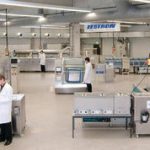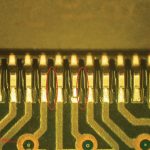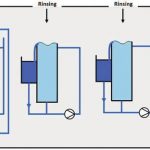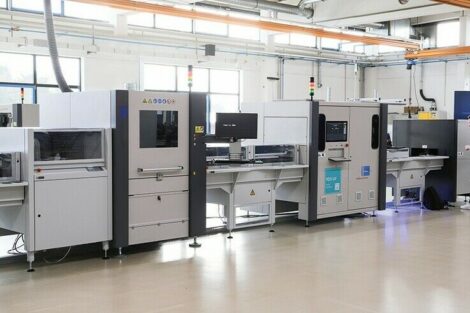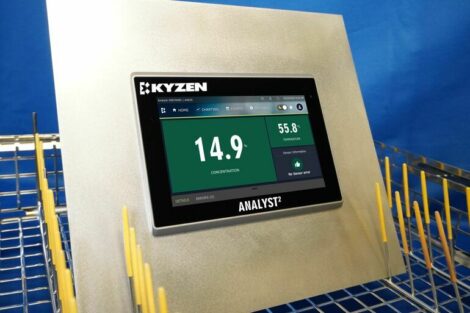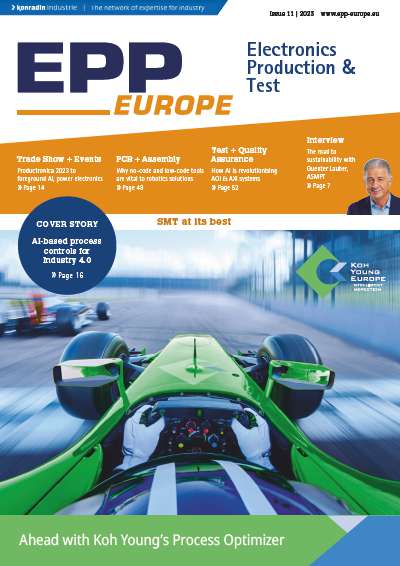One of the leading contract electronics manufacturers (CEM) in the UK installed a new PCB defluxing process, which offers water- and solvent-based cleaning in just one machine to meet all cleanliness requirements of the aerospace industry.
Oliver Manger, Zestron Europe
After a period of intensive investment in specialist equipment, new staff and the development of aerospace-specific quality assurance processes, the CEM achieved the widely known AS9100 international aerospace industry quality standard. AS9100 incorporates the ISO9001 quality management system and additional requirements specified by the aerospace industry. The CEM additionally signed up to the aerospace Supply Chain 21 (SC21) initiative further demonstrating its commitment.
Overall, the CEM offers its customers a wide range of services across the whole spectrum of contract electronics manufacturing, such as:
- Custom design and manufacturing
- Design support and design for manufacturing (DFM)
- Prototyping and new product introduction (NPI)
- Printed circuit board assembly
- Sub and full product assembly
- Test
- Supply chain management
- Warehousing and logistics
- After market services which includes repair and rework
According to AS9100 and IPC-A-610D, which is the most widely used electronics assembly standard in the world, one major requirement for aerospace and defence assemblies are high cleanliness levels. Amongst other requirements, the electronic assemblies have to be free of flux residues and they must have an ionic contamination level below 1.56 µg NaCl eq. /cm². Therefore, the CEM started a project to implement a cleaning process for electronic assemblies to be able to serve customers in the field of military and aerospace
Selecting a cleaning process
At this point the CEM was manufacturing NoClean and had not yet been introduced to the cleaning issues demanded by the aerospace and defence sector. Therefore some main process requirements were defined:
- The cleaning results had to comply with defence/aerospace standards
- The new cleaning process should be fully automated
- It had to cover the board size and to match the throughput
After defining the major requirements for their future process, the available cleaning systems were inspected. As cleaning processes with solvents are widely spread in the aerospace and defence market, the CEM decided to run trials on pure solvent, completely water-free systems. However, neither the flux residues were completely removed nor could the ionic contamination limit be met with a pure solvent process. Due to these results, the CEM looked for alternative cleaning processes and cleaning agents. These were finally found in the Technical Centre of Zestron Europe in Ingolstadt, Germany. This facility features more than 30 different cleaning machines from leading international manufacturers available for cleaning trials. As both water- and solvent-based cleaning agents are available, the question arose if a cleaning process could be run selectively with both types of cleaning media to meet different customers’ requirements, which are typical for subcontractors.
Amongst others, a potential defence customer had already qualified the solvent-based cleaning agent Zestron FA+ for their assemblies. To ensure the compatibility of the used solder material with this cleaning agent and to further determine a suitable water-based cleaning agent, trials were conducted with the CEM’s production assemblies at the Technical Centre. Furthermore to select the best combination of cleaning equipment and cleaning agent, trials with several water-based cleaning agents were conducted in combination with different types of cleaning equipment. After considering all requirements and comparing the cleaning results, the decision was finally made in favour of the NC25 from m.b.Tech with selectively Zestron FA+, a modern, high flashpoint solvent for semi-aqueous cleaning processes, and Vigon A 250, a water-based Micro Phase Cleaning (MPC) agent.
Meeting the cleanliness levels required
The decision for these two cleaning agents was due to the analysis of the cleaning results, which were gained directly after the trials in Zestron’s Analytical Centre. To ensure that the cleaning results met the CEM’s requirements, the inspection was performed as described below:
- Visual inspection according to IPC-A-610D
- Ionic contamination measurement with CM 11 of Multicore in accordance with the IPC test method 650. The evaluation is based on J-STD-001D
- Colour reaction of Flux Test and Resin Test to indicate selective activators respectively resin or rosin from fluxes. The evaluation is also based on J-STD-001D
The analysis of the cleaning results showed that both cleaning agents obtained best results in the above mentioned cleanliness test methods. Both, the water- and the solvent-based process, completely removed flux residues from the assembly surface. The ionic contamination levels were well below the limit of 1.56 µg NaCl eq. /cm² with both cleaning agents.
The cleaning equipment
The decision for the cleaning equipment was based on the aspect that a dip tank process was preferred by the CEM and all tested one-chamber spray-in-air batch machines were not able to match the required throughput. The cleaning equipment is a 4-chamber dip tank machine, which can be loaded with up to five frames, where assemblies are fixed in. These frames are then transferred individually with an automatic transport system and immersed into the cleaning tank. In this first chamber they are agitated by a combination of vertical movement and either a turbulent air supported spray under immersion or ultrasonic. After cleaning, the boards are transported automatically to be pre- and fine-rinsed with deionised water. Finally, the boards are dried in a vacuum supported drying chamber. The combination of hot air and vacuum realises short drying times even under BGAs or in connectors.
Between each transfer from one chamber to the next, the electronic assemblies pass an air knife, which is placed on top of each tank. These air knifes limit the drag out from one tank to another, which in turn leads to a low product consumption.
Due to the patented filtering system, which is specifically designed for MPC cleaning agents, long bath life times can be achieved. This filtering system and the included water treatment system ensure a completely closed loop system to fulfil the latest environmental regulations.
Implementing the process
As the equipment was initially designed for water-based cleaning agents, some slight modifications had to be done by the machine manufacture to be able to run a solvent-based cleaner. Due to these simple modifications of the equipment, the CEM is now able to run the machine selectively with both cleaning agents depending on customer needs and preferences. Both cleaning agents, the solvent- and the water-based product, have a wide process window in terms of flux removal and thus highest cleanliness levels are achieved. In addition, the CEM controls the cleaning results regularly by a Contaminometer CM60. According to customer’s needs, the cleaning process was installed with the solvent-based cleaning agent in the first place. For the last 11 months, the cleaning process has provided consistently good results and so far, there hasn’t been a need for a bath change. With an average consumption of cleaning agent of only 1l per day, the cost for the cleaning agent is low and the process is reliable and efficient. The water-based cleaning agent can be processed for a change at any time to serve additional customer requirements.
Conclusion
By integrating a fully automated cleaning process into their production, which can be used with two different qualified cleaning agents, the CEM Company is now able to comply with the highest cleanliness standards and aerospace/defence specifications according to AS9100 and IPC-A-610D. Customers from all different industries, including aerospace and defence, can now be offered greater support in terms of electronic assembly production.
The success of this project is due to the close collaboration of all parties involved. In this case clearly stated objectives and requirements by the CEM were the basis for the project. The cleaning trials in the Technical Center of Zestron helped the CEM to receive an overview of the different cleaning machines available, helped to pick the most suitable cleaning machine and provided a safe decision making for the investment. The extensive cleaning trials also provided two suitable cleaning agents and assurance for the quality of the cleaning results for the later production process. The modification conducted by the machine supplier further enabled the CEM company to use two different cleaning agents to fulfil different customer requirements while remaining in accordance with the aerospace/defence specifications. In the end all those factors lead to a stable running cleaning process for the production floor with highest cleanliness levels to meet customer requirements.
Zusammenfassung
Ein führender Leiterplattenentwickler und -bestücker in Großbritannien implementierte einen neuen Prozess zur Flussmittelentfernung in eine Maschine, um den kompletten und anspruchsvollen Anforderungen an Reinigung in der Luftfahrtindustrie zu entsprechen.
Leader en Grande-Bretagne dans le développement et l’équipement de circuits imprimés, cette société a mis en place un nouveau process pour éliminer les fondants dans les machines, afin de répondre à l’ensemble des exigences de nettoyage strictes de l’industrie aéronautique.
Share:


